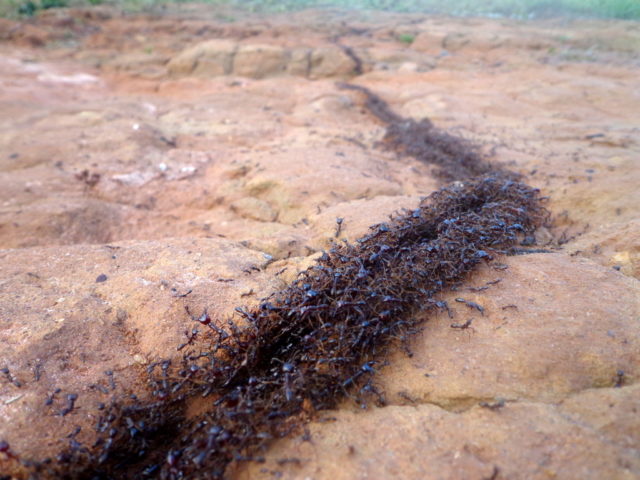Smell ya later: the thing about pheromones

If you’ve been on the internet at all in the past few years, you’re bound to have seen ads for so-called “pheromone perfumes”, claiming to help you score a date by making you smell irresistible. It seems almost too good to be true…
Pheromones are indeed real. They are chemical signals used by some species to communicate anything from attraction to territorial boundaries and even bonding behaviours between parents and offspring. They can be classed into three categories: releaser pheromones, primer pheromones, and kairomones. Releaser pheromones are fast-acting, cause short term behavioural changes and are often used during reproduction to find a mate. Primer pheromones, on the other hand, are slower acting and cause longer term developmental changes. Kairomones are essentially pheromones that have backfired by harming the species it was produced by. Army ants, for example, use a pheromone trail to lead the way back to their colony (like the breadcrumbs in Hansel and Gretel). Not only does this lead their fellow ants back home, it also alerts their predators, like the brown eyed snake, to the location of the colony; these animals have come to associate the scent of the ant’s pheromone with a tasty dinner. Other species make use of this too, like some types of orchid flower. By mimicking the scent of bee sex pheromones, they attract worker bees for pollination.

Ants following a trail marked by pheromones. Image credit: dotun55 via Flickr
In fact, humans have found ways to profit off of animal pheromones too. Certain moth species are a threat to crop yields, and pheromones are the secret to controlling their population. By releasing synthetic female moth sex pheromones, males are lured in the direction of the decoy and thus are not able to find a mate. This disrupts mating and reduces the number of larvae. This method of pest control is called mating disruption1. Scientists have also been looking at potential applications in medicine by investigating the use of pheromones to treat parasitic nematodes in humans and other mammals.
Of course, the question still stands — do humans have pheromones? The answer is a clear… maybe. While no scientist has managed to isolate a human pheromone yet, that doesn’t mean they don’t exist. In fact, there is evidence suggesting that they might. Firstly, many other mammals — from mice to pigs and elephants use pheromones — so why shouldn’t we? A 1994 experiment had a group of female volunteers select who they were most attracted to, based on nothing but the scent of the men’s worn shirts2. Interestingly, women mostly preferred the scent of men with opposite immune systems to their own. This led many to believe that male sweat may contain pheromones. Building on this, androsterone, a sex pheromone released by pigs, is also found in human sweat. Even so, scientists have not been able to conclusively prove that androstanol has the same effect in humans as in pigs — or even any effect at all. If androstanol was a human pheromone, researchers would be able to isolate it and, when presented to any woman, cause the same reaction. The shirt-sniffing experiment has its own problems too. Mainly, it has since not been replicated, which is a hugely important criteria for scientific research to be deemed valid, as it shows the results were not based on trickery, or plain luck. So, while the experiment raises interesting points, and gives some food for thought, it is far from evidence for the existence of human pheromones.
Humans do use scent to send signals — everyone has their very own unique scent profile. Newborn babies can even recognize the scent of their mothers from across the room. However, these smells aren’t pheromones and our reaction to them is largely based on context and previous experiences. Coffee may smell good to you because it’s reminiscent of Sunday family breakfasts, not because its chemical composition is designed to be appealing to humans.
At the end of the day, does it even matter whether humans have pheromones? To the average person out there, no it doesn’t. Some scientists have suggested that we may not even be able to pick up pheromones. Many other species that have been documented to use pheromones possess an additional organ called the vomeronasal organ, or VNO for short. In most humans, the VNO is non-existent and very primitive in the rest. Most agree that it is not functional, as it’s not even connected to the brain. Regular body odour may influence us in a similar way to pheromones, causing us to be more or less attracted to someone based on their smell, even if the chemicals involved aren’t considered pheromones. Most importantly, humans can consciously choose their partners, and, in this way we are distinctly different from most other animals, who choose their partners solely for mating purposes. Our choice of partner is based on much more than whatever initial effect pheromones could have, even if we did have and could detect them. How attractive a person seems based on smell is irrelevant if personalities don’t align, and, as such pheromones may not even play a significant role in human behaviour at all. In recent years, the field of pheromone research has become almost sensationalized to the point that scientists have even suggested scrapping all previous research and starting all over again. Regardless, if you were hoping to score a date with the help of pheromones, I’m afraid you might be out of luck… for now at least, but who nose what the future holds?
This article was specialist edited by Carla Suciu and copy-edited by Sylvia Drozdzik.









